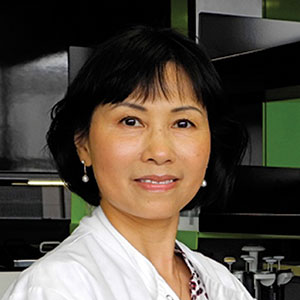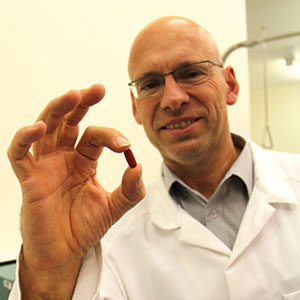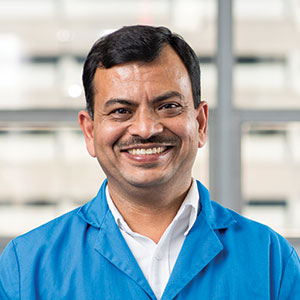Thanks to medical intervention, Australians’ lives are being extended but the health risks caused by our lifestyles, and sometimes our genes, mean many of us will confront years of disease or disability.
Enter the local researchers who are part of the global quest for cures.
We usually expect a medical diagnosis to be followed by the news that there is a drug or treatment to make us better.
In many cases this will be so, but some drugs have become less effective over time, such as the antibiotics used against bacteria that have developed resistance. Others, such as chemotherapy drugs for treating cancer, can have ghastly side-effects, reduce quality of life and may still not deliver the desired result.
As scientists discover more about diseases and genetics, the push is on to design increasingly sophisticated, personalised and targeted medicines.
UniSA researchers are making their contribution to this field – finding new compounds or discovering new uses for existing molecules that can be designed to target specific genes or proteins in our bodies.
New medicines generally work more efficiently and have fewer side-effects, but it can still take a decade, several billion dollars and involve researchers in medicine, biotechnology and pharmacology, to bring a drug to the stage where it becomes available for patients.
Researchers will often screen many thousands of compounds during the early stages of their research to find a handful that show promise.
Once a compound has been identified, it needs to be investigated to see how selective it is towards an important protein or gene responsible for a disease, what happens to it in the body, the doses most likely to be effective, and in what form it may have to be given to patients.
But the route to success has changed dramatically over the past decade, with advances in nanotechnology allowing exciting developments in how drugs can be tweaked and delivered to us with improved safety and efficacy.
 Professor Shudong Wang has established the Centre of Drug Discovery and Development at UniSA with research capabilities spanning drug design, medicinal chemistry, biology and pharmacology to speed up the drug development process.
Professor Shudong Wang has established the Centre of Drug Discovery and Development at UniSA with research capabilities spanning drug design, medicinal chemistry, biology and pharmacology to speed up the drug development process.
She is leading a multidisciplinary research team to develop new and patented drug molecules with the goal of finding effective and low toxic treatments for cancers. This includes those cancers for which there are currently poor prognoses, such as mixed-lineage acute myeloid leukaemia, an aggressive blood cancer in children and older patients.
“We use targeted therapy where you identify the proteins or genes that are critical for cancer cell proliferation and survival,” Prof Wang says.
“We then design small-molecule drug compounds to block the production of those genes or proteins, resulting in cancer cell death.
“When we target those genes or proteins, the compounds are more likely to be less toxic to normal tissues so they are quite different to conventional chemotherapy, which kills both cancer cells and ‘normal’ cells.
“This is a huge advancement for cancer treatment.”
Prof Wang has already had more than 80 patent publications and has several drugs in pre-clinical and clinical development.
She recently identified an anti-cancer agent, MKI-18, that selectively kills cancer cells. With support from grants, including funding from Cancer Council SA, she is evaluating its anti-tumour activity with the hope of progressing to human clinical trials.
“Our MKI-18 and other drug candidates hold great promise for treatment of several types of leukaemia and solid tumours,” she says.
“There is nothing more satisfying than what we are doing, which is finding a cure for cancer patients.”
Prof Wang has established solid connections with industries to ensure the speedy arrival of the drug to the market. Among them is a prestigious collaboration recently established between Prof Wang and China’s leading pharmaceutical company, Yabao Pharmaceutical Group. Prof Wang and her team will identify drug candidates while Yabao will be able to develop and commercialise them in China, with UniSA retaining development rights in all other markets.
Meanwhile, UniSA scientist Professor Xin-Fu Zhou is looking at new ways of using existing drugs. He is part of an Australian and Chinese research team that has recently made two important discoveries in the search for a cure for Alzheimer’s disease. Led by Prof Zhou and Prof Yan-jiang Wang at China’s Third Military Medical University, the team discovered that the drug Edaravone, used in some Asian countries to treat stroke, can alleviate progressive cognitive deficits. They have also made a molecular discovery on one of the complex mechanisms of the disease.
 For Professor of Pharmaceutical Science, Clive Prestidge, the focus is on making better medicines by finding better drug delivery systems. That could mean improving an existing drug by altering its delivery mechanism, or designing an efficient and safe method of delivery for a new drug.
For Professor of Pharmaceutical Science, Clive Prestidge, the focus is on making better medicines by finding better drug delivery systems. That could mean improving an existing drug by altering its delivery mechanism, or designing an efficient and safe method of delivery for a new drug.
“Drugs alone don’t make good medicines,” Prof Prestidge says. “Of the new small molecule drugs being discovered, about 70 per cent of those in the pipeline are not easily delivered. They are poorly soluble or if you want to develop them as a simple oral medicine they have very low absorption in the body.”
He says the challenge is increasingly about using innovative technologies to create effective medicines capable of targeting specific tissues, which gets around the problem of the body’s systemic resistance.
Many drugs of the future will be large biological molecules (e.g. proteins and peptides) and a holy grail in pharmaceutics is to deliver molecules that do not permeate across our gut.
“Rather than using animal models here, we’re developing an artificial gut on a microfluidics chip,” Prof Prestidge says.
“Through an Australian Research Council Linkage grant with an Australian company, we’re using this technology to develop new oral vaccines.”
According to Prof Prestidge, drug effectiveness can be improved by “packaging” a drug into a particle-based carrier for oral and injectable drugs, as well as those delivered through the skin and lungs – the ultimate in localised therapy.
He currently has a National Health and Medical Research Council (NHMRC) grant to work on converting a colorectal cancer drug, irinotecan, which can cause extreme side-effects in patients, from an intravenous form to an oral medicine. The drug has been modified into several carrier systems and is now undergoing animal studies.
Prof Prestidge also founded Ceridia, a UniSA-owned company that is commercialising the Lipoceramic drug delivery technology, a nanotechnology system that creates smart pills and capsules for poorly soluble drugs.
 Professor of Pharmaceutical Sciences, Sanjay Garg agrees that nanotechnolgy is opening up opportunities in drug development that were not possible only a few years ago. He is working on the development of about a dozen new drugs and delivery systems, including anticancer drugs and new antibiotic compounds and formulations for resistant infections.
Professor of Pharmaceutical Sciences, Sanjay Garg agrees that nanotechnolgy is opening up opportunities in drug development that were not possible only a few years ago. He is working on the development of about a dozen new drugs and delivery systems, including anticancer drugs and new antibiotic compounds and formulations for resistant infections.
As Head of UniSA’s Sansom Institute’s Centre for Pharmaceutical Innovation and Development, he works with a cluster of 15 scientists engaged in drug development projects.
One of his team’s projects involves delivering the anticancer drug docetaxel in localised forms, such as the use of a stent inserted after surgical removal of oesophageal tumours. A polymeric film on the stent would release the drug over three months, reducing the likelihood of tumour regrowth and reducing side effects for patients.
Prof Garg is also working with an Australian pharmaceutical company, the University of Adelaide and the University of Newcastle on developing three new compounds for resistant infections in humans and animals.
“We have filed a patent on a novel compound and through our partner company we are in discussions with major multinational veterinary pharmaceutical companies for further development,” he says.
“Nanotechnology has been around for quite a while, but most of the development has happened in the past 20 years.
“The greatest need is in the field of cancer, which is still one of the biggest challenges because there are so many unanswered questions.
“That’s where I hope the new world of drug development and discovery will make a big difference.”
All three UniSA researchers will be relocating to UniSA’s new $230m Health Innovation Building, which is under construction. It will provide collaborative spaces for researchers from different fields to work together to fast-track the drug discovery and delivery process and find possible cures for the major illnesses and diseases of our time.
Find out more at the Sansom Institute website.
UniSA researchers are working on many fronts to find answers to the questions that still remain in our fight against cancer. The University’s ability to combine wide-ranging expertise across many disciplines helps deliver innovative breakthroughs using a combination of new science, new techniques and new technologies. You can support UniSA researchers to continue their work by donating online at unisa.edu.au/giving. 100 per cent of your donation goes directly to UniSA health research.